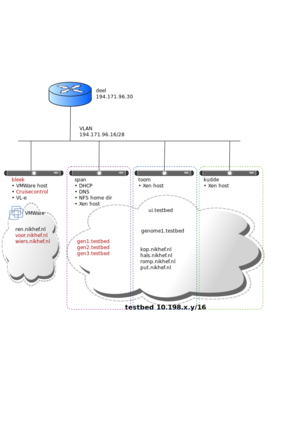Agile testbed
Agile testbed
The Agile testbed is a setup of easy-come easy-go virtual machines for quickly trying out new and experimental software.
It is used in the context of the P4 activity of the VL-e project, the SA3 activity in the EGEE III project and Application support in the BiG Grid project.
The test bed is hosted at the Nikhef data processing facility, and managed by Dennis van Dok, Jan Just Keijser, Mischa Sallé and Willem van Engen.
Hardware
The testbed currently consists of four physical machines: bleek, toom, kudde and span.
| name | type | #cores | mem | OS | disk | remarks |
|---|---|---|---|---|---|---|
| bleek | Intel 5150 @ 2.66GHz | 4 | 8GB | CentOS4-64 | software raid1 2×500GB disks | High Availability, dual power supply |
| toom | Intel E5440 @ 2.83GHz | 8 | 16GB | CentOS5-64 | Hardware raid1 2×715GB disks | |
| kudde | Intel E5440 @ 2.83GHz | 8 | 16GB | CentOS5-64 | Hardware raid1 2×715GB disks | |
| span | Intel E5440 @ 2.83GHz | 8 | 24GB | CentOS5-64 | Hardware raid10 on 4×470GB disks (950GB net) | DHCP,DNS,NFS,LDAP |
Network
The network between these machines is a bit particular: They all live in the same VLAN (194.171.96.16/28) but they all have an extra alias interface in the 10.198.0.0/16 range. The Xen DomUs on each of the Xen machines that live in that address range are given connectivity to the other DomUs in the same VLAN without using NAT, and connectivity to the outside with SNAT. Here's an example of the iptables on span:
Chain POSTROUTING (policy ACCEPT 58M packets, 3693M bytes)
pkts bytes target prot opt in out source destination
0 0 ACCEPT all -- any any 10.198.0.0/16 194.171.96.16/28
436 63986 ACCEPT all -- any any 10.198.0.0/16 10.198.0.0/16
1 190 SNAT all -- any any 10.198.0.0/16 anywhere to:194.171.96.28
So all traffic from a DomU on span will appear to have come from span to the outside.
Note that DomUs that have interfaces in the public address range do not need SNAT at all, they simply connect to the hosts xen bridge.
There is a separate network attached to each machine to allow IPMI management and Serial-Over-Lan.
Software Installation
The central machine in the network is span, it runs
- dnsmasq for DNS and DHCP based on /etc/hosts and /etc/ethers
- NFS server for the home directories and ssh and pem host keys
The other Xen machines, toom and kudde, run Xen 3.1. On these machines the creation and destruction of virtual machines is best left to the generate-machine and destroy-machine scripts, part of the nl.vl-e.poc.ctb.mktestbed software package.
Operational procedures
adding a new machine
- edit
/etc/hosts /etc/ethers
to add the new machine, and hardware address.
- Restart dnsmasq
/etc/init.d/dnsmasq restart
- on span.nikhef.nl, run
/usr/local/bin/keygen <hostname>
to pre-generate ssh keys.
- on span, run
/var/local/hostkeys/generate-knownhosts.sh
- on all machines, do
cp /var/local/hostkeys/ssh_known_hosts /etc/ssh/ssh_known_hosts
- (optional) generate or request an X509 host certificate. For local machines in the .testbed domain, Dutchgrid certificates won't be issued, but a testbed-wide CA is in use, ask Dennis. The certificate and key are stored in
/var/local/hostkeys/pem/<hostname>/hostcert.pem /var/local/hostkeys/pem/<hostname>/hostkey.pem
- place a 'firstboot' script on span in
/var/local/xen/firstboot/<hostname>
(it will be downloaded and run the first time after installation of the machine.)
- run generate-machine on the Dom0 of choice.
